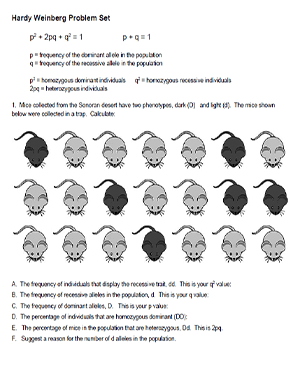
Hardy-Weinberg equilibrium (HWE) is a fundamental concept in population genetics that describes the theoretical relationship between allele frequencies and genotype frequencies in an ideal, non-evolving population.
Students can practice using the Hardy Weinberg equilibrium equation to determine the allele frequencies in a population. This set of 10 questions gives students just enough information to solve for p (dominant allele frequency) and q (recessive allele frequency). They will also calculate the percentage of heterozygous individuals (2pq).
I designed this worksheet for an AP Biology class and was revised April 2019. There is an older version that has many of the answers posted online, so this one has been changed slightly so that students cannot easily find the answers and take a shortcut.
The ten problems may be too many for some students, I usually ask my students to consider how much practice they need. If they are confident after doing 3-4 of the problems, then the rest can be optional.
Time Required: 20-30 minutes
Grade Level: 11-12
HS-LS3-3 Apply concepts of statistics and probability to explain the variation and distribution of expressed traits in a population.

